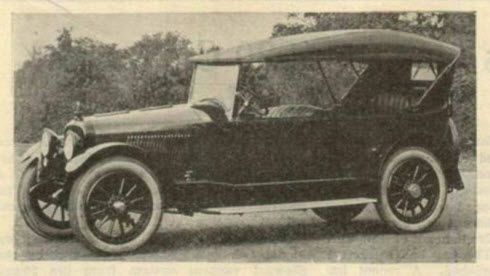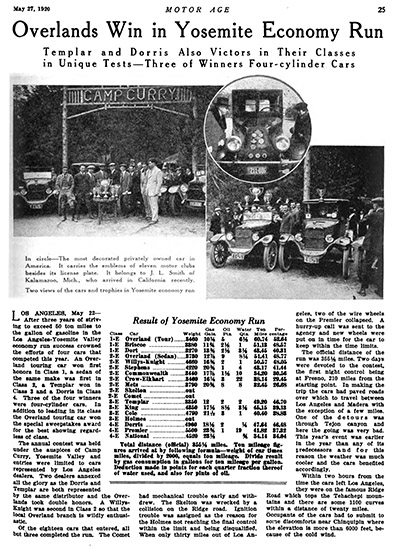


Framed or unframed, desk size to sofa size, printed by us in Arizona and Alabama since 2007. Explore now.
Shorpy is funded by you. Patreon contributors get an ad-free experience.
Learn more.

- Baldwin 62303
- Baldwin VO-1000
- Cold
- No expense spared
- Tough Guys
- Lost in Toyland
- And without gloves
- If I were a blindfolded time traveler
- Smoke Consumer Also Cooks
- Oh that stove!
- Possibly still there?
- What?!?
- $100 Reward
- Freeze Frame
- Texas Flyer wanted
- Just a Year Too Soon
- WWII -- Replacing men with women at the railroad crossing.
- Yes, Icing
- You kids drive me nuts!
- NOT An Easy Job
- I wonder
- Just add window boxes
- Icing Platform?
- Indiana Harbor Belt abides
- Freezing haze
- Corrections (for those who care)
- C&NW at Nelson
- Fallen Flags
- A dangerous job made worse
- Water Stop
Print Emporium
L.A. to Yosemite: 1920

May 1920. Yosemite National Park. "Prize Cup, Fourth Annual AAA Economy Run, Los Angeles to Camp Curry." An early test of fuel efficiency sponsored by Standard Oil of California. 8x6 inch glass negative originally from the Wyland Stanley collection of San Francisciana, acquired and scanned by Shorpy. View full size.
Posted on the Porch
"Hold On To Uncle Sam's Insurance" was a poster created by James Montgomery Flagg. He is also the person who created the "I Want You For U.S. Army" recruitment poster originally designed during WWI. An enlargement of the poster is below.
The U.S. Department of Veterans Affairs website says this.
There have been several other life insurance programs for service members. Most notably National Service Life Insurance (WWII era), Veterans' Special Life Insurance (Korean War era); and since the Vietnam War era Servicemembers' Group Life Insurance (SGLI). The SGLI now includes both Active Duty and Reserve members and the maximum insurance available is $400,000.

One Survivor
Of all of the cars in the Yosemite Economy Run, only one manufacturer survives today. The Overland marque went away in 1926 and the Willys-Knight nameplate in 1932, but their parent company, Willys-Overland survived. After going through many transitions and owners we now know the firm as Jeep. There was an Overland trim package for the Jeep Grand Cherokee from 2002 - 2004.
One other company survived until 2010: Commonwealth Cars. In 1922 Commonwealth became Checker who many of us know as makers of the Checker Cab (they also built some passenger cars and specialty vehicles like airport limousines). Although taxicab production ended in 1982, the firm continued producing automobile parts for General Motors and other firms. Checker filed for bankruptcy in early 2009 and ceased to exist on January 14, 2010.
All of the other manufacturers participating in the Yosemite Economy Run were defunct by the close of 1926.
And the Winners Are ...
As Zcarstvnz (and tterrace!) correctly surmised, the rig in our photo is a Dorris touring car, Model 6-80. Click below to enlarge.
Dorris
I believe this is a 1920 Dorris made by the Dorris Motor Car Company of St. Louis. The combination of the two vents on top of the hood, slanted hood louvers, radiator shape, and lights leads me to this conclusion. There is a possibility of this being a 1919 model; however, since it was entered in an economy run, where most likely all vehicles were entered by manufacturers or dealerships, the 1919 model would have been an unlikely choice given these runs were highly publicized (why show off an outdated model?).
Although the company started in 1906, its origins were in the St. Louis Motor Carriage Company founded by George Preston Dorris and John L. French. French decided to move the company to Peoria, Illinois in 1905, but Dorris decided to remain behind. Production from 1906 - 1926 was never large with only 3,100 cars and 900 trucks made during this time. Their company slogan, "Build up to a standard, not down to a price," was part of the reason their vehicles were so expensive (up to $7,000 for a closed car). Quality was very high. Although there were many distibutors 90% of production was sold in the St. Louis area. It appears that only sixteen Dorris cars still exist. The Dorris family still owns six of them.
The building the cars were made in is now on the National Register of Historic Places (added February 10, 2000). The application form here, starting at Section 8, has a wealth of detail about the company and the building including some photos. Other online information is here and here. Another photo of a 1920 Dorris is shown below.

Next Stop Atlantic City
Is that Nucky Thompson at the wheel?
Stumped
Though I am now and have ever been a real car nut, somehow I cannot place this ride. The headlamp placement is vaguely reminiscent of Franklin, but in 1920 that marque had not yet adopted a phony radiator (theirs were air-cooled engines) in response to dealer demands that the car look like the competition.
Fortunately, Shorpy's discerning clientele will quickly come in with not only the car's make and year but also the line foreman's census data and a Street View of his birthplace.
Oh, and any ideas about what's written in the dust above the rear fender?


























On Shorpy:
Today’s Top 5